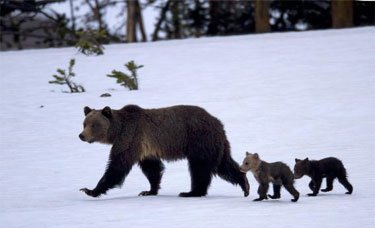
The female grizzly bear, referred to as the Wapiti sow, killed Brian Matayoshi on July 6, 2011 and then killed John Wallace on August 27, 2011, after officials declined to hunt the bear responsible. The Wapiti sow was finally trapped in late September and euthanized October 2nd after four days of forensic analysis and chin stroking.
Jessica Grose, in Slate, describes how the swift and hearty justice dealt out to man-killing grizzlies in simpler and less-grovelly-toward-Nature times has been replaced by a new intensely ethically conscientious regime that will only kill bears which are deemed to have behaved with “unnatural aggression” or which have been found to have eaten people.
In the bad old days, they knew what to do with man-killing bruins.
The first extensively documented death by grizzly within Yellowstone Park’s borders was the fatal mauling of 61-year-old government laborer Frank Welch in 1916. And the park’s first extensively documented judicial execution of a grizzly soon followed. Some historians suspect the bear that killed Welch was abnormally ill-tempered because his toes had been ripped off when he escaped from a trap in 1912. Whatever the bear’s motives, though, Welch’s fellow laborers decided that “Old Two Toes†deserved to die for his crimes. Men from the road camp where Welch had been working placed some edible garbage in front of a barrel filled with dynamite. When the bear began to eat, they blew it to smithereens.
That was how grizzlies were treated if they injured humans in the early days of Yellowstone: They were killed.
Not today. Today, when Ephraim or Ephraimina takes out a tax paying citizen, there is the equivalent of a judicial procedure. There are major exculpatory loopholes. And even totally guilty bears are put down reluctantly, as big, salty tears pour down the faces of the responsible officials.
Every bear is pwecious, you see.
The euthanization of the bear known as “the Wapiti sow†was the culmination of a series of horrifying events that had gripped Yellowstone for months, and alarmed rangers, visitors, and the conservation biologists tasked with keeping grizzly bears safe. In separate incidents in July and August, grizzlies had killed hikers in Yellowstone, prompting a months-long investigation replete with crime scene reconstructions and DNA analysis, and a furious race to capture the prime suspect. The execution of the Wapiti sow opens a window on a special criminal justice system designed to protect endangered bears and the humans who share their land. It also demonstrates the difficulty of judging animals for crimes against us. The government bear biologists who enforce grizzly law and order grapple with the impossibility of the task every day. In the most painful cases, the people who protect these sublime, endangered animals must also put them to death.
Whenever a grizzly bear commits a crime in the continental United States, Chris Servheen gets a call at his office at the University of Montana in Missoula. Servheen has been the Grizzly Bear Recovery Coordinator for the U.S. Fish and Wildlife Service for three decades. …
Before Servheen, Gunther, and their bear management colleagues could decide what to do, they’d need a lot more information. Was a grizzly bear in fact responsible for this second death? If so, which bear did the mauling? And what were the circumstances that led up to attack—was it provoked or had some hiker just been caught unaware? The answers to those questions would determine whether a precious animal would need to die. …
Wildlife biologists like Kerry Gunther help the park’s crime-scene investigators by speculating on a bear’s emotional state. Based on the evidence at hand, he tries to determine whether a given act of bear aggression might have been a natural behavior—the result of being startled while feeding on an elk carcass, for example, or seeing someone approaching her cubs. If a bear appears to have followed a hiker down the trail instead of backing off, or if it attacked campers while they were asleep, that would be more unusual—the result, perhaps of a deranged grizzly mind.
If you blunder into a bear that is thought to have attacked and killed you out of natural aggression (you violated that bear’s space, dude!) or via an impulse of self defense, that’s just too bad for you. The bear goes free, as long as he refrains from dining on your pitiable remains.
The authorities in question reluctantly draw the line at actual predation, simply because they are afraid of the public response to tolerating man-eaters in National Parks.
The zero-tolerance policy for man-eating bears invites an obvious question, though. Once a bear kills someone, whether it’s out of some wild-animal psychopathy or a natural inclination to defend her young, why wouldn’t she eat the corpse? Everyone agrees that it’s natural for grizzlies to eat carrion—they’re scavengers, after all. When I ask Servheen whether grizzlies can get “a taste for human blood”—whether a grizzly that starts eating people-meat will desire it endlessly—he dismisses the idea. “That’s for horror stories in movies,” he says. “Bears don’t get a taste for human blood. There’s no studies that show that.”
No studies show it, in part because every time a bear eats someone, they kill it. Not that it’s something that would ever be studied—biologists would never want to take the risk of keeping a bear that had eaten a person in the greater bear population. “We don’t want to test whether bears really get a taste for people,†Gunther explains. “The public wouldn’t appreciate us using them as subjects.” That’s for horror movies, but it seems like even the bear biologists think there might be some truth to the campfire legends.





Please Leave a Comment!